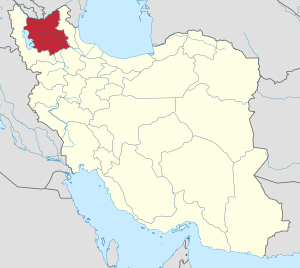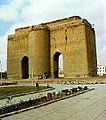East Azerbaijan province facts for kids
Quick facts for kids
East Azarbaijan Province
استان آذربایجان شرقی
|
|
|---|---|

Location of East Azerbaijan within Iran
|
|
| Region | Region 3 |
| Capital | Tabriz |
| Counties | 21 |
| Area | |
| • Total | 45,650 km2 (17,630 sq mi) |
| Population
(2016 Census)
|
|
| • Total | 3,909,652 |
| • Density | 85.644/km2 (221.817/sq mi) |
| Time zone | UTC+03:30 (IRST) |
| ISO 3166 code | IR-03 |
| Main language(s) | Persian (official) local languages: Azerbaijani |
| HDI (2017) | 0.785 high · 17th |
East Azerbaijan Province (Persian: استان آذربایجان شرقی Āzarbāijān-e Sharqi; Azerbaijani: شرقی آذربایجان اوستانی) is one of the 31 provinces of Iran. It is located in Iranian Azerbaijan, in the northwest part of the country. This province shares borders with Armenia, the Republic of Azerbaijan, and other Iranian provinces like Ardabil province, West Azerbaijan province, and Zanjan province.
The capital city of East Azerbaijan is Tabriz. This province is part of Region 3 of Iran. In 2016, about 3.9 million people lived here.
Contents
Exploring East Azerbaijan's Geography
East Azerbaijan covers an area of about 47,830 square kilometers. It is known for its beautiful natural landscapes.
Mountains and Rivers
The highest point in the province is Sahand Mountain. This volcanic peak is about 3,707 meters (12,162 feet) tall. It lies south of Tabriz. The province has three main mountain ranges:
- The Qara Daq Mountains
- The Sahand and Bozqoosh Mountains
- The Qaflan Kooh Mountains
Climate and Weather
The climate in East Azerbaijan is a mix of Mediterranean and cold semi-arid weather. Gentle breezes from the Caspian Sea can affect the lower areas. In winter, temperatures can drop to -10 to -15 °C (14 to 5 °F). The best times to visit are spring and summer.
Understanding East Azerbaijan's History
East Azerbaijan is a very old part of Iran. Its history goes back thousands of years.
Ancient Roots
Around 331 BCE, during the time of Alexander III of Macedon, a warrior named Attorpat led a revolt here. Because of him, the area was later called Attorpatkan. Over time, this name changed to Azarabadegan, Azarbadgan, and finally Azarbayjan.
Some historians believe that the prophet Zoroaster was born in this region. This was near Lake Orumieh, in a place called Konzak City.
Modern History and Changes
This province has seen many changes and has been important to different countries. For example, Russia tried to have a strong influence here for about 300 years. They even occupied the area several times.
The Constitutional Revolution of Iran, a big movement for change, started in this region in the late 1800s.
In 1945, the Soviet Union helped create the Azerbaijan People's Government in what is now East Azerbaijan. This was a time of political change in the region.
Culture and Traditions of East Azerbaijan
East Azerbaijan has a rich and unique culture.
Language and Folklore
The main language spoken here is Azerbaijani. It is a Turkic language, similar to the language spoken in the Republic of Azerbaijan and Turkey. The region also has many traditional dances and folk songs.
Famous People and Heritage Sites
Many famous scholars, poets, and leaders come from East Azerbaijan. Some well-known poets include Mowlana Baba Mazeed and Ostad Mohammad Hossein Shahriyar. The current Supreme Leader of Iran, Ali Khamenei, is also from this region.
The Iran's Cultural Heritage Organization has listed 936 important historical sites in the province. One example is "Zahak Citadel," an ancient ruin that was used for thousands of years.
East Azerbaijan is often mentioned in Persian literature by Iran's greatest writers and poets.
East Azerbaijan Today: Industry and Education
Today, East Azerbaijan is an important industrial center in Iran.
Key Industries
The province has over 5,000 factories and manufacturing units. Some of the major industries include:
- Glass and paper manufacturing
- Steel, copper, and petrochemical products
- Vehicle and auto-parts industries
- Food industries
- Leather and shoe production
Handicrafts and Carpets
East Azerbaijan is especially famous for its handicrafts. Tabriz carpets are known worldwide for their beautiful designs and colors. There are about 66,000 carpet workshops in the province, employing around 200,000 people. These workshops produce over 70% of Iran's carpet exports.
The province is also rich in natural minerals, with many mines.
Nature Reserves
UNESCO has named two areas in East Azerbaijan as Biosphere Reserves:
- Lake Urmia
- Arasbaran
Colleges and Universities
East Azerbaijan is home to several well-known universities:
- Sahand University of Technology
- Tabriz University of Medical Sciences
- University of Tabriz
- Azerbaijan University of Tarbiat Moallem
- Tabriz Islamic Arts University
- University of Maragheh
- Engineering and Technical College of Bonab
- Islamic Azad University of Bonab
- Islamic Azad University of Tabriz
- Islamic Azad University of Shabestar
- Islamic Azad University of Maragheh
- Islamic Azad University of Miyaneh
- University College of Nabi Akram, Tabriz
Notable People from East Azerbaijan
Many important figures in history, arts, and sports have come from this province:
- Qatran Tabrizi, a poet
- Ahmad Kasravi, a historian
- Sattar Khan, a revolutionary leader
- Ali Daei, a famous Iranian soccer player
- Karim Bagheri, another soccer star
- Parvin E'tesami, a poet
- Shams Tabrizi, a mystic
- Vartan Gregorian, a well-known academic leader
- Mohammad Hossein Shahriar, a contemporary poet
Images for kids
-
Arasbaran Forests, a UNESCO reserved biosphere
See also
 In Spanish: Provincia de Azerbaiyán Oriental para niños
In Spanish: Provincia de Azerbaiyán Oriental para niños
- Aras Free Zone
- List of East Azarbaijan cities and towns by population








